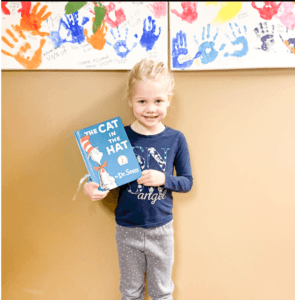Speech and language and BOOKS!
Parents often ask what they can do to encourage the development of their child’s language skills or which apps will best help their children improve. Of the many incredible apps that are at our disposal, the best tool you have access to is a book. You may have some books at home, or you have access to hundreds of books at your local library. Reading promotes pre-literacy, early literacy, receptive language, and expressive language skills in children of all ages – even before they are talking. Here are a few tips and tricks for how to read to and with your child.

For toddlers:
- Have your child hold the book and help them to orient the book properly. Show your child where the top and bottom are.
- Guide your child to turn the pages.
- Glide your finger and your child’s finger over the words as your read. This helps to develop print awareness – the knowledge that printed letters and words are symbols that have meaning. This also teaches kids to read from left to right from top to bottom.
- As you’re reading, you can introduce your child to a wide variety of vocabulary. Point to each picture on the page. Label the pictures. Describe the pictures – their shape, color, size, function.
- If your child is active and has difficulty attending to books try adding reading to an already established routine. A great time to do this is before or after a mealtime when your child is in a highchair.
For children with emerging expressive language skills:
- Choose a book with repeating lines. Some examples are Brown Bear, Brown Bear, What Do You See? and There Was An Old Lady Who Swallowed a Fly. As you go through the book, stop when you are mid-way through a repeating line. Your child will be expecting the end of the line or phrase and may finish it independently. For example, while reading The Very Hungry Caterpillar I may say “but he was still….” and your child may finish the line by saying “hungry!”. Praise your child’s attempts to use language.
- For children who are a little older, books with repeating lines allow for them to begin participating in reading because they are able to begin putting meaning to the printed text. If they know that the last word in the phrase is “hungry” they can then look at the printed word “hungry”.
For preschool and school aged-children:
- Have your child tell you what is happening on each page. Children don’t need to be able to read the words to be able to tell a story based on the pictures. Encourage your child to use complete sentences. If your child makes sound or grammar errors, repeat their words and sentences so that your child hears a correct model. Listen to your child’s story and encourage them to explain what happens first, middle, and last.
- A parent can also use books to target both receptive and expressive language goals. If your child has a receptive language goal to identify objects, you can use the pictures and say “point to the car” or “where is the flower?” You can target pronouns receptively by looking at the pictures and saying “point to she”. Then you can target pronouns expressively by saying “What is the girl doing?” to which your child can respond “she is running”.
The opportunities for growth using books are endless. Give it a try! If you want to build a personal library for your child visit https://ohioimaginationlibrary.org/. Children ages birth to five years old can enroll to receive a free book each month. If you have concerns regarding your child’s language or literacy skills, visit http://www.abcpediatrictherapy.com for more information.
Developmental Checklist
Is your child meeting their developmental milestones?
 Skip to content
Skip to content